Burrs continue to be a significant issue for part manufacturers, but it is not just the burr that is the issue. Edges must be configured as either sharp, broken or have a radius to a specified tolerance. In addition, deburring must not damage or destroy nearby surfaces, change part color or deposit oxides or other material.
Part complexity, combined with difficult material properties, make deburring a challenge for many part manufacturers seeking more cost-effective deburring, more precise edge finishing, faster throughput and reduced side effects. Some manufacturers must completely deburr a part rapidly. For example, many auto part makers must completely deburr a part in 4 seconds or less to match the production rate for that part and avoid slowing the transfer line. For others, the goal is to assure a precise and repeatable edge geometry.
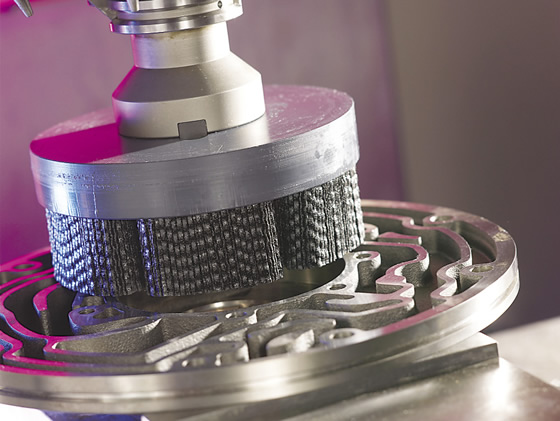
Courtesy of Weiler
Abrasive-filled nylon brushes are effective for deburring the narrow passageways on automatic transmission housings.
Although all deburring operations pose possible pitfalls, presented here are 10 of the most challenging deburring applications and the methods for achieving success.
1. Composites. Deburring composite materials tops the list. Some composites are comprised of two metals while others, such as electrical circuit boards, may have layers of different plastics, ceramics and metals. Aircraft materials like carbon fiber-aluminum combinations have significantly enhanced strength-to-weight ratios, but part edges must meet strict requirements, for obvious safety reasons.
The free edges (top and bottom exposed surfaces) of composite laminates are especially susceptible to cracking, higher stress, delamination, water absorption, ongoing fraying and chemical attack, all of which negatively impact product life or performance. Deburring can cause, prevent or improve any of these issues.
Because each material in a composite requires a different “treatment” to generate acceptable edges and surfaces, the best process to improve one material’s quality characteristics may worsen others.
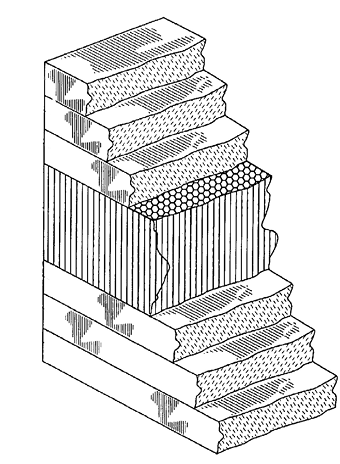
Courtesy of U.S. Patent and Trademark Office
Deburring composite materials, such as this one with seven component layers, is particularly challenging.
But there is another, more subjective issue: What determines an edge when machining different layers of material? People generally think an edge is what they see on the outer surface, but in composites, every transition from one layer to another can be an edge. Thus, a product may have many internal edges, and each may be critical to product performance.
To help minimize burrs and finish edges when deburring composites, understand the material properties in the composite and what the real customer quality criteria are—at each interface. Although several may meet the minimum requirements, pick the best machining/finishing process.
Apply the best cutters, which will require working with toolmakers to tap into their knowledge base. Also, use optimal cutting conditions and keep the layers tightly together.
2. Intersecting holes. Intersecting holes have a 3D edge configuration, and the burr thickness and height changes at each point on the intersection. This means a deburring process based on a consistent burr size may not work well.
In addition to swivel hand tools, examples of deburring tools for intersecting holes include Cogsdill Tool Product Inc.’s Smooth Edge Deburring Tool, J.W. Done’s Orbitool and Brush Research Manufacturing Co. Inc.’s Flex-Hone. Thermal deburring is also highly effective on deburring intersecting holes in many metal parts, even ones with relatively small holes. If intersections have to be smoothly finished, electrochemical deburring and Kennametal Inc.’s Extrude Hone abrasive flow machining provide high-quality edges for almost any configuration. On large holes, abrasive-filled rubber or paper bullet shapes are quick and effective.
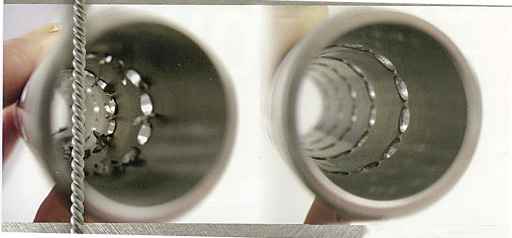
Courtesy of Brush Research Manufacturing
The Flex-Hone from Brush Research Manufacturing is one tool that’s effective for deburring cross-holes. A surface prior to treatment with the Flex-Hone (left) and after treatment (right).
The challenge becomes much more acute when the holes are smaller than ⅛ " (3.175mm) in diameter and deeper than 10 times diameter because most tools or processes cannot reach into those configurations. One example of difficult-to-deburr, deep intersecting holes is found in engine crankshafts, because removing all burrs typically must be done in 4 seconds or less, as noted earlier. The rate of deburring makes it challenging.
3. Transmission housings. Automatic transmission housings are a complex maze of narrow passageways that typically have burrs on each side of their machined passages. The labyrinth openings make it a challenge to fully deburr them. Abrasive-filled nylon brushes and other types of brushes can reach below the edge and abrade away the burr as the brush is drawn over the edge.
The same technique works on the hundreds of inches of milled edges in automobile engine blocks.
4. Jet engine blisks. Blisks are jet turbine components with numerous short turbine blades. These are usually machined from a single forging as opposed to machining the blades, welding them in place and then finish machining the blisk. Blisks are made from difficult-to-machine, heat-resistant superalloys that must withstand temperatures up to 3,000° F (1,649° C).
These expensive products must have precise airflow and every edge has to be perfect, meaning free of burrs and configured to a specific edge curvature, which may vary for each row of blades. Robotic handling plus CNC machining programs that minimize burr generation provide the best solution to these exacting requirements.
5. Polyether ether ketone. PEEK is one of those materials used by the medical and aerospace industries for various reasons, including strength, inertness and, for medical parts, biocompatibility. But machining PEEK often leaves a feather-thin burr that many manufacturers find difficult to remove without affecting surface finish, size, color and other part requirements.
Patrick Byrne, sales and marketing manager for Comco Inc., Burbank, Calif., a manufacturer of miniature abrasive blasters, explained that while it is difficult to safely deburr PEEK with small knives, a micron-sized soft abrasive directed at high velocity on the target deburrs without damaging intricate part geometries and finishes. Cryogenic tumbling also works for removing external burrs on some PEEK parts.
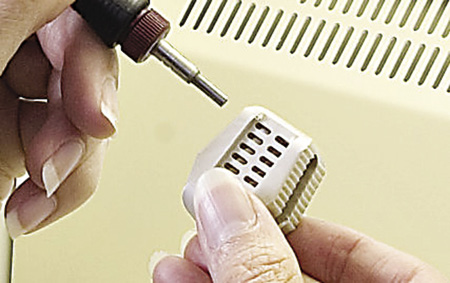
Courtesy of Comco
When deburring PEEK parts, a micron-sized soft abrasive directed at high velocity on the target deburrs without damaging intricate part geometries and finishes.
6. Teflon. Teflon tends to produce rather tenacious burrs that move when being cut and flex when being blasted. The key is to either fight the burrs with very sharp knives or freeze the part before cutting or blasting. Machining the part while frozen and no longer ductile can prevent burr formation. The same approach will work for many plastic parts, but choosing the correct temperature to prevent part breakage is critical.
7. Threads. Threads can have burrs at hole entrances and exits, when present, on both sides of the thread crests and on most slot edges. The burrs at the start and end of threads are thicker than crest threads and positioned in different planes, so a single deburring operation is often not effective. Tumbling, or mass finishing, processes can remove some of the burrs, but it is not generally effective on the ends of threads.
Tumbling can beat burrs down so they are less objectionable, but care is required to prevent mashing burrs into the thread valleys, causing interference during assembly. Hand deburring, electrochemical and the SurfTran thermal deburring processes can be effective for all threads.
Designing parts to accommodate burrs solves some issues, and thread rolling makes a beautiful, burr-free thread. Also, thread grinding can effectively prevent the formation of large burrs.
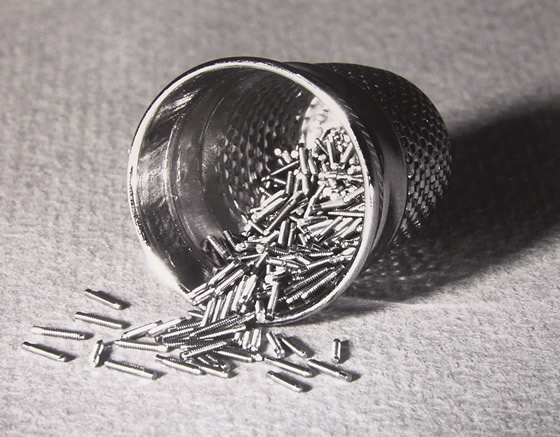
Courtesy of U.S. Department of Energy
Threads can have burrs at hole entrances and exits, when present, on both sides of the thread crests and most slot edges.
8. Wing spar components. Many structural aircraft parts have numerous milled pockets to reduce weight, which adds to their expense. The material left is typically thin and any dings, scratches or other damage is sure to get the part rejected because these are stressed parts expected to be used in airplanes to safely carry passengers for decades. Many pockets are deep, so the deburring process, which may also have to impart smooth part walls, becomes problematic.
Vibratory finishing is often used, but that requires relatively large machines. Brushing is the prime removal process because it can deburr while the part is fixtured in a machine tool. The key is to select the correct brushing filament shape, embedded abrasive material, filament length and machining parameters.
9. Micro mechanical components. It’s always been a challenge to make microparts—such as gears, extremely thin levers and escapement plates—that have burr-free edges at 30× magnification and smooth edge radii that do not exceed 0.001 " (0.025mm). Today, the requirements call for even smaller and thinner parts, in quantities from a handful to millions and in an array of materials not previously imagined. The minute part size, microscopic tolerances, extreme criticalness of edges and challenge of machining advanced titanium alloys, shape-memory alloys and other newer metals and plastics further complicate edge finishing of microparts.
Chemical deburring, electropolishing, centrifugal barrel tumbling and manual deburring are suitable for many of these parts, but sometimes the only solution is to prevent burr formation in the most difficult-to-deburr areas. The microstamping industry is probably the best example of this burr-free approach, but those who laser machine parts have also developed solutions, such as using picosecond and femtosecond lasers that leave no burrs on many materials. The leaders in micromolding have similarly spent a lot of experimental time to examine fluid flow and minimize flashing on microparts. While lasers may be able to quickly burn the flash, handling the parts to better orientate the flash takes time and money that can be better applied elsewhere.
10. Microscale medical parts. The medical field is another challenging area for deburring, but, surprisingly, the use of lasers followed by electropolishing has successfully removed laser debris, which is technically molten metal, from stent edges. Other medical components that go into the body, such as bone screws, plates, heart-assist devices and items to suppress pain, have to be free of burrs to prevent metal particles from getting into the blood stream and entering the heart and irritating or cutting adjacent tissue. The edges left after deburring, like the rest of the product, must be surgically clean. Because the products or the edges may only be slightly larger than the diameter of a human hair, magnification is required to determine if burrs are present.
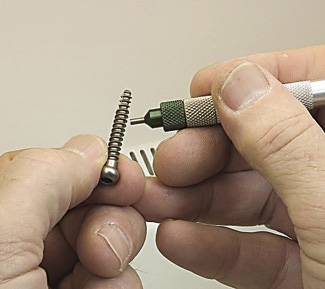
Courtesy of Comco
Components that go into the body, such as this bone screw, must be free of burrs to prevent metal particles from entering the blood stream.
In addition, the microscopic operating tools have stringent edge requirements. Surgical instruments must have sharp, burr-free edges. This requires extreme edge finishing on minute edges and, again, a surface that’s free of bacteria and other pathogens.
Effectively deburring parts poses numerous obstacles, but the demands of even the most challenging applications can be overcome with the proper tools and techniques. CTE
About the Author: Dr. LaRoux K. Gillespie has a 40-year history with precision part production as an engineer and manager. He is the author of 12 books on deburring and over 220 technical reports and articles on precision machining. Contact him at [email protected].
Related Glossary Terms
- abrasive
abrasive
Substance used for grinding, honing, lapping, superfinishing and polishing. Examples include garnet, emery, corundum, silicon carbide, cubic boron nitride and diamond in various grit sizes.
- abrasive flow machining
abrasive flow machining
Finishing and deburring operation for holes, inaccessible areas or restricted passages. Done by clamping the workpiece in a fixture, then extruding semisolid abrasive media through the passage. Often, multiple parts are loaded into a single fixture and finished simultaneously.
- alloys
alloys
Substances having metallic properties and being composed of two or more chemical elements of which at least one is a metal.
- brushing
brushing
Generic term for a curve whose shape is controlled by a combination of its control points and knots (parameter values). The placement of the control points is controlled by an application-specific combination of order, tangency constraints and curvature requirements. See NURBS, nonuniform rational B-splines.
- burr
burr
Stringy portions of material formed on workpiece edges during machining. Often sharp. Can be removed with hand files, abrasive wheels or belts, wire wheels, abrasive-fiber brushes, waterjet equipment or other methods.
- ceramics
ceramics
Cutting tool materials based on aluminum oxide and silicon nitride. Ceramic tools can withstand higher cutting speeds than cemented carbide tools when machining hardened steels, cast irons and high-temperature alloys.
- composites
composites
Materials composed of different elements, with one element normally embedded in another, held together by a compatible binder.
- computer numerical control ( CNC)
computer numerical control ( CNC)
Microprocessor-based controller dedicated to a machine tool that permits the creation or modification of parts. Programmed numerical control activates the machine’s servos and spindle drives and controls the various machining operations. See DNC, direct numerical control; NC, numerical control.
- electrochemical deburring
electrochemical deburring
Variation on electrochemical machining designed to remove burrs and impart small radii to corners. The process normally uses a specially shaped electrode to carefully control the process to a specific area. The process works on material regardless of hardness.
- flash
flash
Thin web or film of metal on a casting that occurs at die partings and around air vents and movable cores. This excess metal is due to necessary working and operating clearances in a die. Flash also is the excess material squeezed out of the cavity as a compression mold closes or as pressure is applied to the cavity.
- grinding
grinding
Machining operation in which material is removed from the workpiece by a powered abrasive wheel, stone, belt, paste, sheet, compound, slurry, etc. Takes various forms: surface grinding (creates flat and/or squared surfaces); cylindrical grinding (for external cylindrical and tapered shapes, fillets, undercuts, etc.); centerless grinding; chamfering; thread and form grinding; tool and cutter grinding; offhand grinding; lapping and polishing (grinding with extremely fine grits to create ultrasmooth surfaces); honing; and disc grinding.
- precision machining ( precision measurement)
precision machining ( precision measurement)
Machining and measuring to exacting standards. Four basic considerations are: dimensions, or geometrical characteristics such as lengths, angles and diameters of which the sizes are numerically specified; limits, or the maximum and minimum sizes permissible for a specified dimension; tolerances, or the total permissible variations in size; and allowances, or the prescribed differences in dimensions between mating parts.
- superalloys
superalloys
Tough, difficult-to-machine alloys; includes Hastelloy, Inconel and Monel. Many are nickel-base metals.
- tap
tap
Cylindrical tool that cuts internal threads and has flutes to remove chips and carry tapping fluid to the point of cut. Normally used on a drill press or tapping machine but also may be operated manually. See tapping.
- thread rolling
thread rolling
Chipless, cold-forming material-displacement process where a rolling head is pressed into the workpiece to create threads. The material is stressed beyond its yield point, which causes it to be deformed platically and permanently. There are three basic types of rolling heads: axial, radial and tangential.
- tolerance
tolerance
Minimum and maximum amount a workpiece dimension is allowed to vary from a set standard and still be acceptable.
